Commentary
Q&A with Queensberry’s Andrew Davison
Working as Sheffield City Council’s strategic development partner, Queensberry is delivering the £470m Heart of the City, transforming the area between The Moor, Fargate and the Devonshire Quarter.
The scheme includes new retail, grade A workspaces, bars and restaurants, live entertainment venues, new homes, a hotel and public realm.
Place Yorkshire spoke to Andrew Davison, director of Queensberry, about what makes the scheme special.
Heart of the City has been around for a while as a city centre aspiration for Sheffield. When did Queensberry first get involved, what were Sheffield looking for, and why did your experience make you the right firm for the job?
Queensberry has been working alongside Sheffield City Council as strategic development partner since 2016 to lead the delivery of Heart of the City following the need to take the development on a new journey from one that was retail-focused to one that was mixed-use.
Queensberry’s experience comes from a commercial developer’s perspective, with strategic consultants and team members having significant experience in all sectors of mixed-use developments in the UK and overseas – when we were appointed, we were already regenerating towns and cities across the UK including Belfast and Bath, and of course we’re very proud to have successfully delivered the £100m Glass Works development in Barnsley town centre.
Sheffield City Council is leading an approach that brings together the public and private sectors to redefine and regenerate an entire city centre district. This approach recognised early on that the council must initiate and lead a major, coordinated investment plan to provide the quality of spaces and placemaking that attracts the most interesting occupiers and future investors: a piecemeal approach would never achieve this.
Seven years on, the partnership is nearing completion of a £470m mixed-use development programme, which continues to do things differently. Delivery of low-carbon office buildings, renovation of long-term, vacant heritage assets and the creation of a ‘living wage zone’ point to a wider set of metrics of success than just price per square foot.
The scheme is already acting as a catalyst, triggering further investment and redevelopment across neighbouring locations – the most notable being the Cole Store redevelopment.
Working with the traditional street layout, modern and existing architecture is being combined to provide a sophisticated place to live, work, shop and stay. Heart of the City acts as the lynchpin within the centre to other major landmark locations, in Barker’s Pool, Fargate, Division Street and The Moor.
How did the phasing come together?
In 2018 the revised masterplan was finalised which incorporated various new uses to create a well-needed focal point within Sheffield. Key to this was the retention and use of more of the existing streetscape and several existing historic buildings and their facades.
The first phase Isaacs House (a mix of offices and shops) and Burgess House (apartments) was developed speculatively following the successful completion of Grosvenor House and the letting to HSBC as the anchor tenant.
Subsequent phases were built once a significant leasing milestone had been achieved which proved commercial demand and thus mitigated the financial exposure and construction risk.
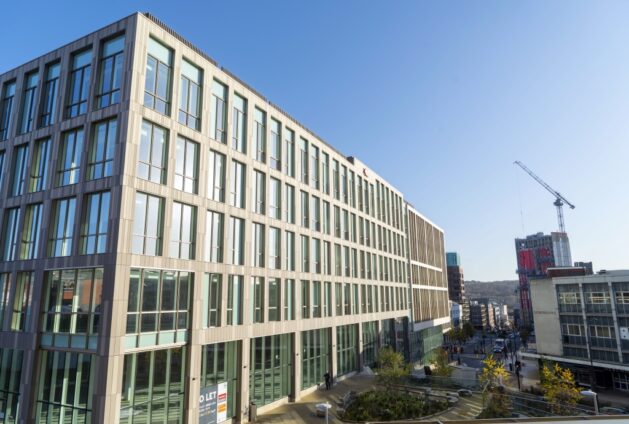
Grosvenor House was completed in 2019. Credit: Scott Merrylees
A phased, block-by-block, approach to delivery ensured the scheme remained flexible and able to respond to changing market and occupancy trends, during a development programme that included Brexit and Covid-19. For example, the scheme is not heavily reliant on retail for its long-term viability. Workspace was split into corporate space and flexible workspace. The housing offer is both rental and private ownership, and open spaces and entertainment spaces prevail throughout.
Separate consultancy teams were appointed for each phase ensuring their detailed design maintained a unique identity respectful of, but independent from the other phases.
City centres need to be flexible and adaptable to meet changing market conditions, not for five or10 years but for 20 years and beyond. A truly mixed offer is required to be successful and sustainable – Heart of the City is delivering this for Sheffield.
What’s the story with office space?
All of the proposed office development is either now completed or in the final stages of construction with tenants such as HSBC, CMS, Henry Boot, National Education Group, and DLA Piper either in occupation or in the middle of their fit-out.
- Grosvenor House – completed and occupied by HSBC and CMS.
- Issacs Building and Athol House – completed, with Henry Boot to move into 12,800 sq ft at Issacs this autumn.
- Elshaw House – practical completion expected in November 2023, with the top two floors signed up.
From a potential 300, 000 sq ft there is currently 225, 000 sq ft of office space now let with several ongoing negotiations for the remainder of the space underway. We anticipate by the end of 2023 at least 250, 000 sq ft will be let.
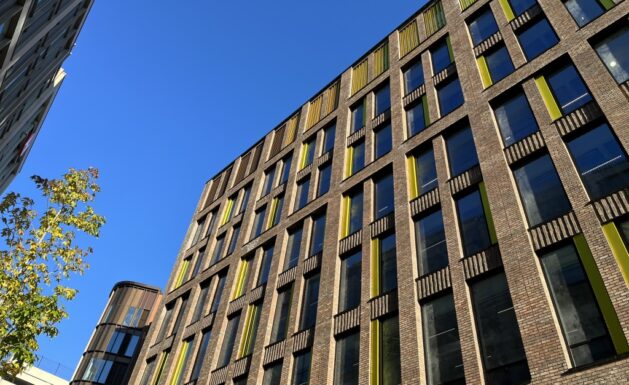
Henry Boot is about to relocate to Isaacs. Credit: via Altitude
HSBC and CMS have demonstrated that businesses want to be in the centre of the city by relocating from fringe locations, placing them at the centre of the Heart of the City district with restaurants, cafés, bars, shops, and cultural attractions on their doorstep.
With a current undersupply of prime grade A space in the market. Heart of the City is perfectly positioned to respond.
Workplaces are being transformed by the demands of a younger workforce and dynamic businesses. Heart of the City will provide modern and flexible working environments that offer co-working opportunities, innovative design and an occupier-centric approach.
This new business district will be a meeting place and a forum for debate and collaboration. It will be where Sheffield meets to be inspired and spark creativity.
Why is the Cambridge Street Collective such an important part of the project?
Cambridge Street Collective, along with the neighbouring Leah’s Yard and Bethel Chapel developments, is Heart of the City’s cultural and social focal point. It was designed to have multiple occupancies with the agility to move with food and beverage trends. Together the two sites provide both day and night entertainment and a venue capacity of 2,000 people.
Sitting so close to Pound’s Park, which has been a hugely popular addition, Cambridge Street Collective will bring something fresh and exciting to Sheffield’s food and drink scene and provide a new hub of activity, bringing a critical mass of footfall back to the area.
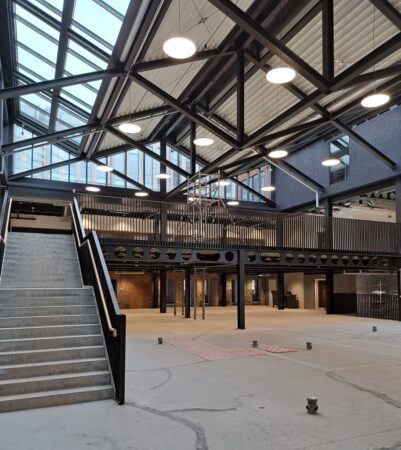
Cambridge Street Collective will be a focal point. Credit: Place North
With the expertise of the operator Blend Family and a truly stunning venue built on Sheffield’s heritage, it will become a diverse and inspiring destination, featuring some of the best independent food and drink companies the city has to offer.
It will be a 27,000 sq ft food hall set over three floors, encompassing over 24 kitchens, a cookery school, a bakery, and a mix of traditional, Asian and rooftop bars.
Matt Bigland and his team believe the time has come for Sheffield to be braver with its food offer and wants Cambridge Street Collective to truly embrace the diversity the city has to offer.
COMMENT: Matt Bigland of Blend Family
“This venture will reinvigorate the city centre. It will allow traders to test products and lean on bigger footfalls without taking a traditional 15-year lease and having to put their life savings on the line.
“It will take a bit of time to curate the perfect selection of kitchens. We needed to build trust with different communities and explain that we want their traditional, authentic cooking. We’ve never wanted bland or deep-fried food, we always wanted granny’s best recipes.
“We also want the food hall to be a platform for new talent. We already run a programme called Future Food Stars, where we look for unique foodie entrepreneurs and provide them with somewhere to run their business and develop their brand. We’re looking for those people who are creating amazing food but don’t have any means to share it. It’s very in keeping with the spirit of Sheffield. The city looks after its own, and that’s what we want to showcase.”
The Leah’s Yard heritage project seems hideously tricky to stack up commercially. What’s the thinking there, and what can we expect to see?
It is challenging for the private sector to make these types of complex heritage projects stack up financially in the short term, so this is why the public sector needs to intervene.

Leah’s Yard will be where makers can meet their market. Credit: via Altitude
The building is an existing listed Mester and was taken back by the council many years ago. The building has been in disrepair for many years but because of its iconic status, it needed to be repurposed and repositioned in line with a changing society.
Sheffield City Council has made the bold decision to invest in the refurbishment for the long-term good of the city centre. I think we all agree we need to find ways to utilise our heritage assets, as they add so much to the character and identity of our urban fabric.
Queensberry has made it its mission to retain attractive heritage assets across Heart of the City, while also ensuring we create new spaces that are usable and sustainable to the local economy. Leah’s Yard has a great story within our city, and it encapsulates the independent, hands-on identity that Sheffield is so well known for.
There has always been a market here for smaller businesses that need somewhere to work but also a place to showcase their stock outside of the internet. Realising this paved the way to finalising an operator to manage these local businesses and whilst this isn’t the most commercially viable of buildings, it adds significant non-tangible social benefits to Sheffield’s economy.
The redevelopment will bring the building back to its former glory, offering bright new opportunities for our independent business community as it recovers from the pandemic. It will also create curiosity and bring new reasons for people to visit the city centre and shop locally.
Once the work is completed, expected to be in spring 2024, the venue will be run by Tom Wolfenden, CEO of SSPCo, which manages the Cooper Buildings on Arundel Street, and James O’Hara of the Rockingham Group, which runs bars such as The Great Gatsby, Public and Picture House Social.
The duo make the perfect team to breathe new life into the site by transforming it into an experience-led destination for local independent retailers and businesses, creative workshops and social events. A bustling central public courtyard will be surrounded by small boutique shops, while the first and second floors will host around 20 independent working studios.
It works as a great catalyst for bringing businesses, that would remain on the periphery, into the city centre.
Tell us about the public realm.
Having an extensive, attractive, and high-quality public realm is so important for the success of any scheme and its value cannot be underestimated. Heart of the City developed a pallet of materials that are not only sustainable but have reinvigorated the existing streetscape and made the surrounding streets safer and more attractive places to sit and walk, adding unprecedented value to the surrounding buildings.
With environmental sustainability in mind, this scheme includes a series of new quality public spaces, from green streets to attractive squares. Where once stood a place dominated by underpasses and a traffic roundabout, we now have Charter Square – an attractive oasis within the busy city centre environment.

Pound’s Park is a post-Covid response to the need for outdoor urban spaces. Credit: via Altitude
We created Pound’s Park, which is reinventing the expectations of a city park. It will create something entirely bespoke to Sheffield – a green park that closely aligns with the city’s evolving environmental ambitions, improves mental and physical wellbeing, and greatly enhances accessibility in the area. It will prioritise cyclists and pedestrians – creating a safer, more vibrant, and less polluted environment for city living.
The pandemic clearly highlighted that open public spaces in our busy urban environment are more important than ever. However, public realm does not deliver the instant overnight commercial value that a building would, so the council being the chief investor allows them to put long-term public benefit first.
Queensberry, alongside the council, has understood the importance of this and is investing heavily in world-class spaces, such as Pound’s Park and Charter Square. The new public spaces help interlink all the scheme’s elements and phases together and provide a genuine sense of place and character.
Is there a particular selling point with the apartments?
Since bringing the new Burgess House homes to market last year, agent Redbrik has sold all but one of the apartments – 51 of 52. Sales were targeted at owner-occupiers as Heart of the City attempts to create a community made up of people who will take pride in the area and enjoy the vibrancy of city centre living.
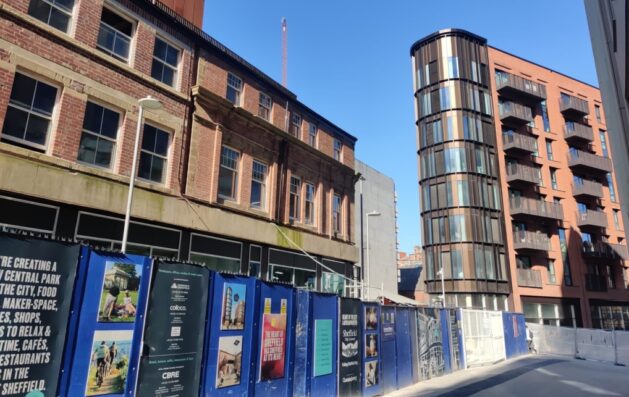
Shown on the right, the Burgess building has sold well. Credit: via Altitude
The apartments within Burgess House are very spacious meeting all modern standards. Due to the apartments only being available to owner-occupiers and not buy-to-rent investors, buyers appreciated how this approach would create a sense of community and placemaking not necessarily seen in other developments.
With a mix of studio, one, two and three-bedroom apartments, the scheme is also offering opportunities to first-time buyers through the government’s Help to Buy initiative, a first within the city centre.
We’re not surprised to see Burgess House prove so popular, as a key focus of Heart of the City has been to make the city centre far more attractive and liveable, with less traffic congestion and landmark new public spaces.
Finally, was meeting Sheffield’s undersupply of hotel rooms a key point from the start?
When developing the vision for Sheffield it became apparent that the hotel stock within Sheffield was very underprovided for, with no new hotels built in Sheffield for more than 10 years. In addition, there was a clear gap for an upper-midscale hotel with only one other significant hotel at this level within the city centre.
A Radisson Blu hotel overlooking the Peace Gardens is planned to be open for April 2024, offering a more distinct and high-end experience than the current offer in Sheffield, with original interiors and rooftop dining. This will be an asset to the city for weekend visitors and business travellers alike.
I’m sure the success of Heart of the City will help encourage more quality hotels to move into the city centre, rather than be located on the periphery, as they have traditionally been in Sheffield.

New floors have been added to a heritage building for the hotel. Credit: via Altitude




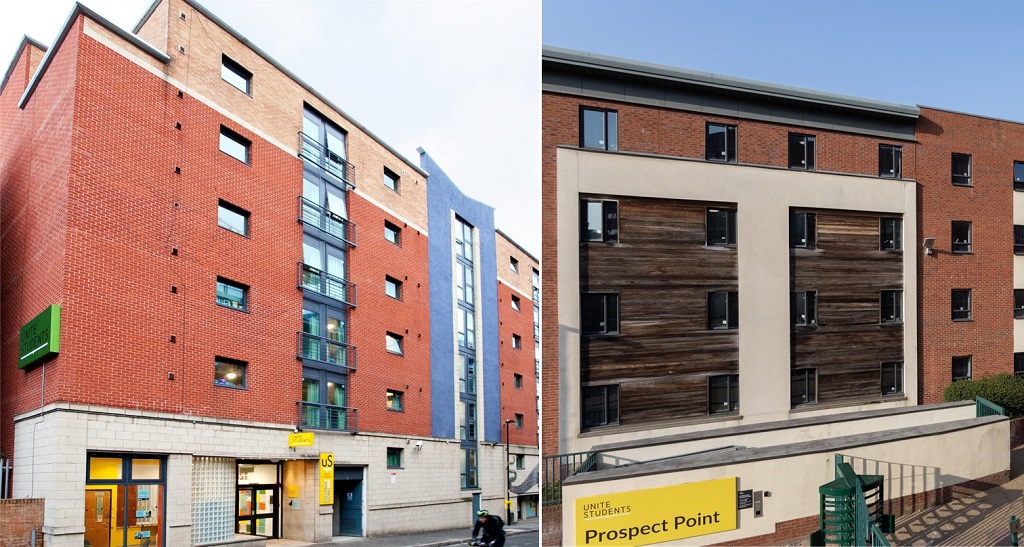
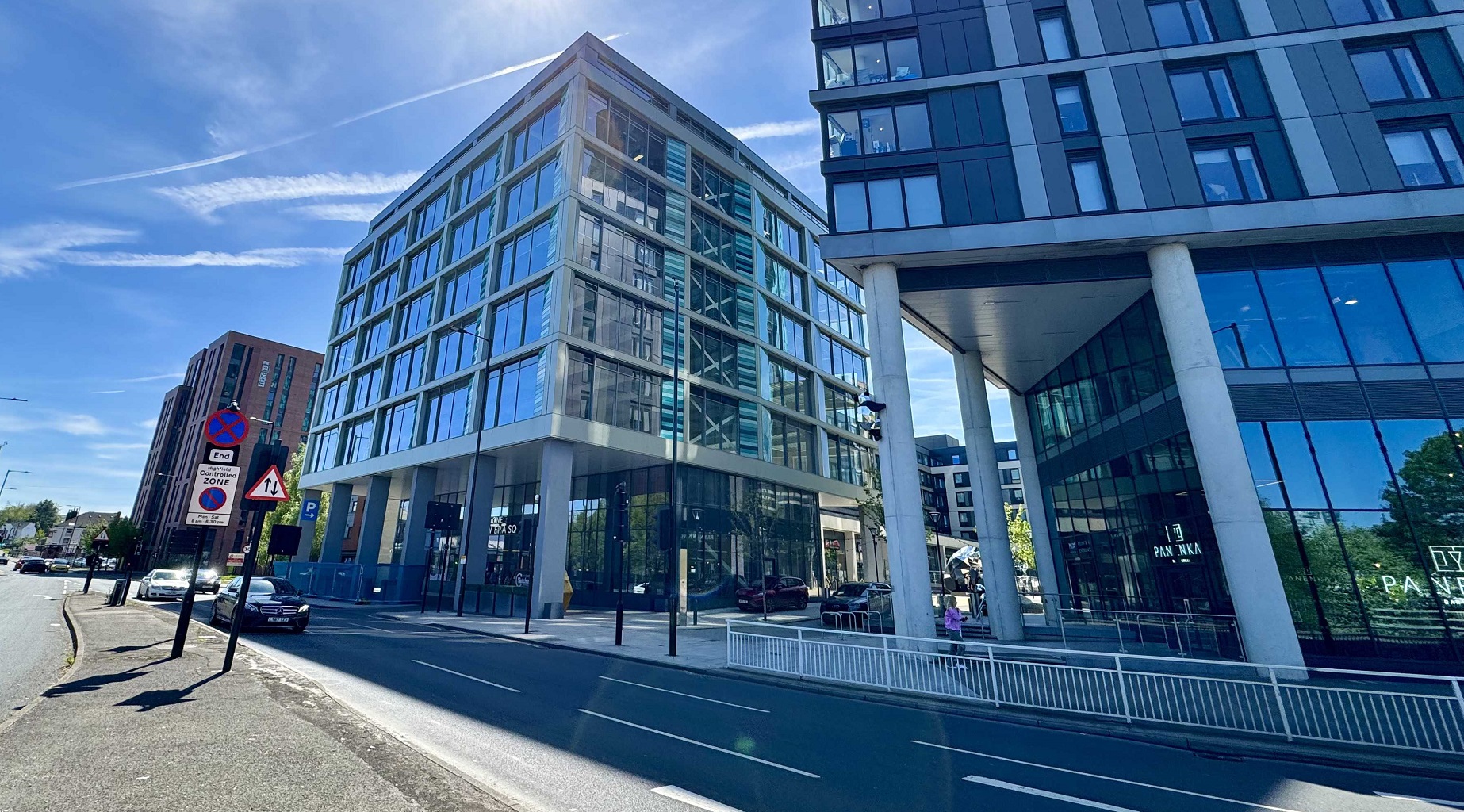
It’s looking great and, with 35,000 residents living in the revitalised City Centre, it should have a positive beating heart to match the Heart of the City development. This could be the blueprint for revitalising town and city centres – quality high rise apartments, interesting bespoke retail outlets, attractive public realm and well designed flexible work environments. If the new buildings can fill up with appropriate users, this will be a great place to live, shop, work and visit.
By PJS